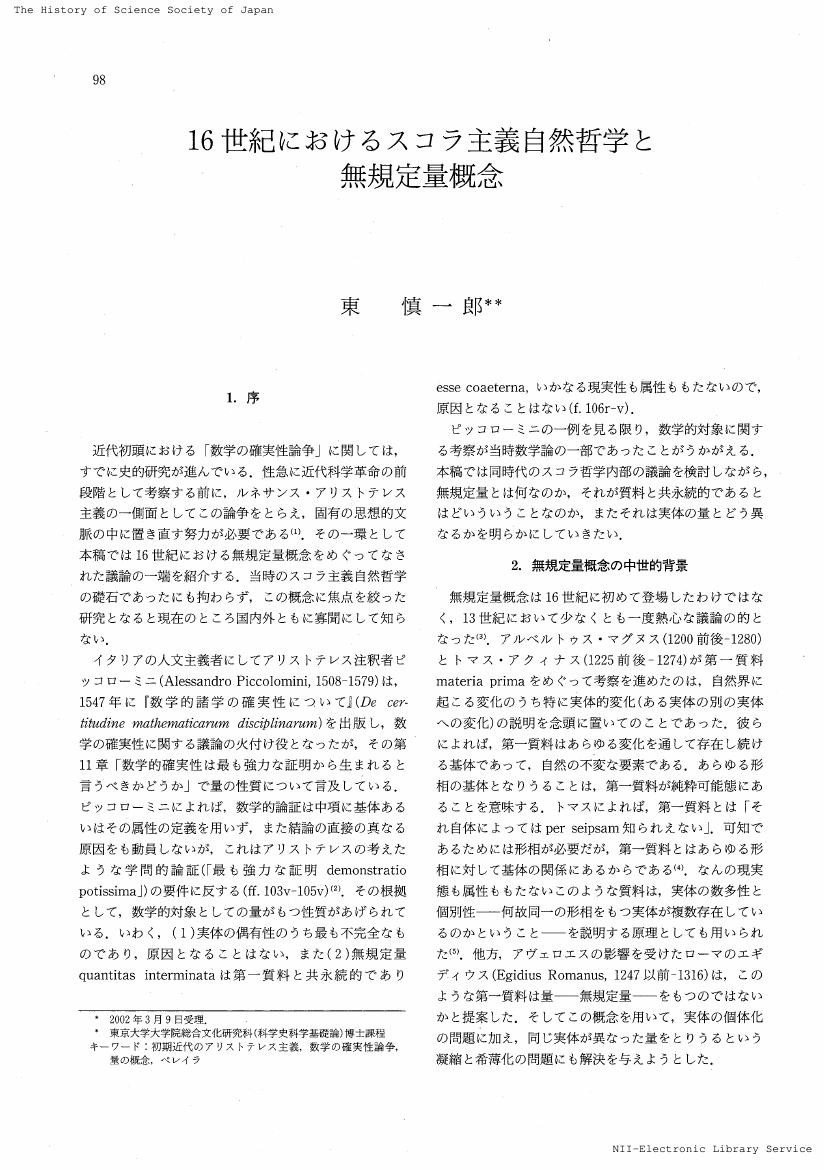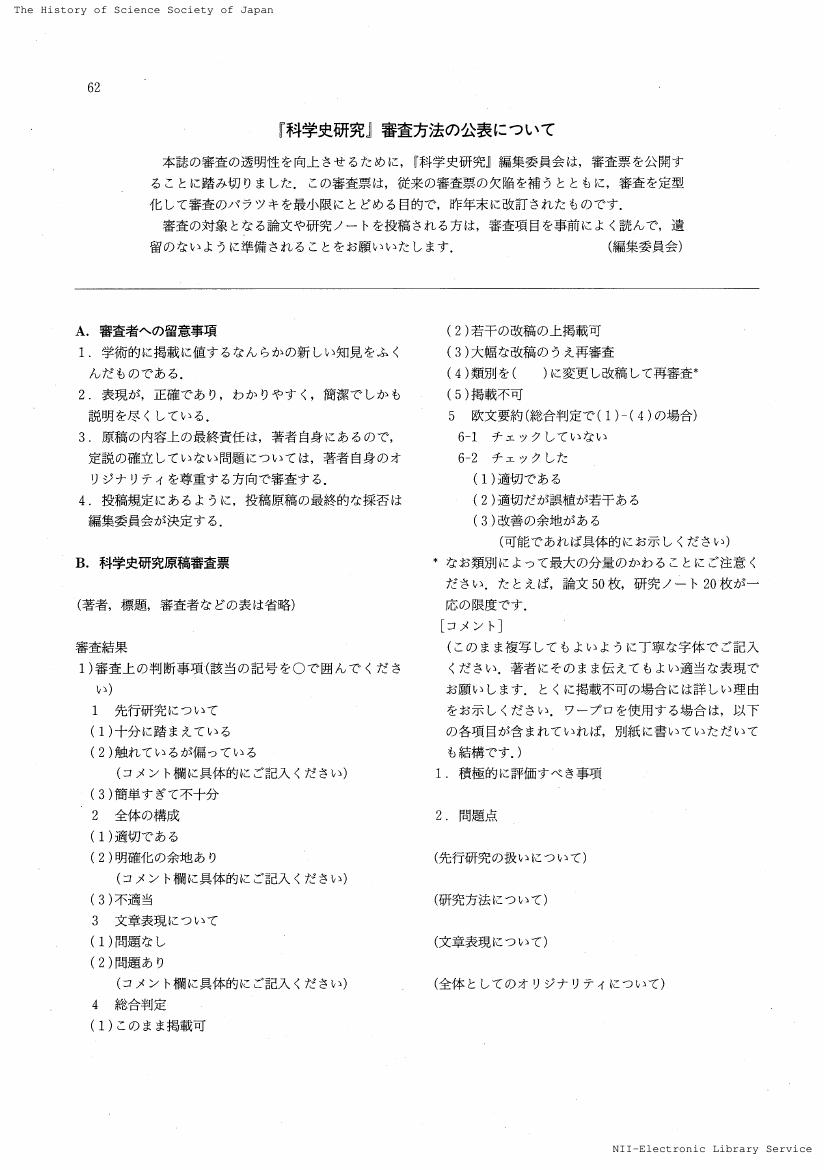1 0 0 0 OA シンポジウム:加賀と近江 : 地域と人脈から見る近世科学史(2002年度年会報告)
1 0 0 0 OA 第49回 日本科学史学会 年会・総会 報告
- 出版者
- 日本科学史学会
- 雑誌
- 科学史研究 (ISSN:21887535)
- 巻号頁・発行日
- vol.41, no.223, pp.170-176, 2002 (Released:2021-08-13)
1 0 0 0 OA 紹介
- 出版者
- 日本科学史学会
- 雑誌
- 科学史研究 (ISSN:21887535)
- 巻号頁・発行日
- vol.41, no.223, pp.177, 2002 (Released:2021-08-13)
1 0 0 0 OA 『窮理通』の主要典拠ながら忘れられていた蘭書
- 著者
- 野村 正雄
- 出版者
- 日本科学史学会
- 雑誌
- 科学史研究 (ISSN:21887535)
- 巻号頁・発行日
- vol.41, no.224, pp.193-202, 2002 (Released:2021-08-13)
A Dutch book entitled Algemeene Aardrijksbeschrijving (General Geography) by Jacob de Gelder in 1803-1808, which was introduced into Tokugawa Japan, is found to be one of the crucial sources for Kyuri-tsu, 1836 by Hoashi Banri. This Dutch book covers related topics such as astronomy, meteorology, geology and natural geography, but not human geography. French physics developed by LaPlace, etc. is emphasized in this book: The "geography " at that time implied several subjects related to the earch. Translations or quotations from this Algemeene Aardrijksbeschrijving to Kyuri-tsu amount to a quater of the whole content.
1 0 0 0 OA 小惑星と恒星と平山清次 : 稀薄な抵抗物質の塊の中での天体の運動
- 著者
- 吉田 省子
- 出版者
- 日本科学史学会
- 雑誌
- 科学史研究 (ISSN:21887535)
- 巻号頁・発行日
- vol.41, no.224, pp.203-213, 2002 (Released:2021-08-13)
Kiyotsugu Hirayama (1874-1943), who is renowned for his finding of families of asteroids in 1918, had two astronomical interests in addition to the family after his return home from U.S. (1915-1917): the explanation of gaps in the distribution of the mean motion of the asteroids, and the theory of stellar evolution including the origin of binary system and the origin of stellar energy and the mechanism of the periodic variable stars. Although it seemed as if his researches of stellar evolution originated in another interest different from asteroid-researches, certainly it's half-true, all these were interrelated, too. No one states this view. He approached these problems through celestial mechanics. Given resisting particles in the solar system, he considered theoretical effect of resistance on the motion of the asteroids in the librating region. And he speculated the capture theory of the stars that the cloud (mass of resisting particles) in the interstellar space can capture several stars passing through it. He said that his capture theory was naturally connected with the stellar evolution. In short, resisting particles (medium) was his key idea. His capture theory was an extension of the asteroid-researches under the resisting-medium hypothesis. But the theory not only was an extension of asteroid-researches, but also was caused by general interest shared with astronomers at the time. Finally, physical ground of his statement in 1933 that the outbreak of the asteroid families might have occurred after the medium had dissipated, was on his theory of solar system formation based on his capture theory.
1 0 0 0 OA 朝鮮総督府下の特許 : 『朝鮮発明調査書』について
- 著者
- 富田 徹男
- 出版者
- 日本科学史学会
- 雑誌
- 科学史研究 (ISSN:21887535)
- 巻号頁・発行日
- vol.41, no.224, pp.214, 2002 (Released:2021-08-13)
- 著者
- 三浦 宏文
- 出版者
- 日本科学史学会
- 雑誌
- 科学史研究 (ISSN:21887535)
- 巻号頁・発行日
- vol.41, no.222, pp.88-97, 2002 (Released:2021-08-16)
The Vaisesika system is known as ancient Indian realism. In this paper, the author intends to examine the concept of time and space in Prasastapadabhasya (6C. A.D.), which is one of the main texts in this system. The concepts of Time and Space in Prasastapadabhasya are contemplated as three types of, substance. They are kala(time), akasa(ether), and dis(direction). First, kala is the cause of idea of differences between past phenomenon and non-past (future and present). Therefore, the concept of time in Prasastapadabhasya is not considered to be a linear, which is its understanding in modern physics. It might be clear truth that such concept is absolutely differs from one. Next, as for space there are two types of concept. One is dis, the other is akasa in Prasastapadabhasya. Dis is what informs us the place where substance with the form is. It should be emphasized this concerned with substance with the form. Thus, we can see that dis is the visual space form is vision perceives. On the other hand, akasa is the substance which functions is a medium of the transmission of the Sabda (sound). Hence, we can see that akasa is the auditory space. To sum up, the theory of time and space in this system can be concluded that is composed of Empirical Epistemology and Categorical Realism.
1 0 0 0 OA 16世紀におけるスコラ主義自然哲学と無規定量概念
- 著者
- 東 慎一郎
- 出版者
- 日本科学史学会
- 雑誌
- 科学史研究 (ISSN:21887535)
- 巻号頁・発行日
- vol.41, no.222, pp.98-101, 2002 (Released:2021-08-16)
1 0 0 0 OA マックス・プランク協会における戦時研究見直しプログラム(アゴラ)
1 0 0 0 OA 優生保護法の歴史像の再検討(科学史入門)
- 著者
- 松原 洋子
- 出版者
- 日本科学史学会
- 雑誌
- 科学史研究 (ISSN:21887535)
- 巻号頁・発行日
- vol.41, no.222, pp.104-106, 2002 (Released:2021-08-16)
1 0 0 0 OA 仁科芳雄と戦前日本の物理学(科学史入門)
- 著者
- 矢崎 裕二
- 出版者
- 日本科学史学会
- 雑誌
- 科学史研究 (ISSN:21887535)
- 巻号頁・発行日
- vol.41, no.222, pp.107-111, 2002 (Released:2021-08-16)
- 被引用文献数
- 1
1 0 0 0 OA 科学史研究をふりかえって : 敗戦後の科学史研究と学会
- 著者
- 山崎 俊雄 大沼 政徳
- 出版者
- 日本科学史学会
- 雑誌
- 科学史研究 (ISSN:21887535)
- 巻号頁・発行日
- vol.41, no.222, pp.112-117, 2002 (Released:2021-08-16)
1 0 0 0 OA 紹介
- 出版者
- 日本科学史学会
- 雑誌
- 科学史研究 (ISSN:21887535)
- 巻号頁・発行日
- vol.41, no.222, pp.118-126, 2002 (Released:2021-08-16)
1 0 0 0 OA 前野良沢の『翻訳運動法』,『測曜〓圖説』と蘭書典拠
- 著者
- 野村 正雄
- 出版者
- 日本科学史学会
- 雑誌
- 科学史研究 (ISSN:21887535)
- 巻号頁・発行日
- vol.41, no.221, pp.1-13, 2002 (Released:2021-08-16)
In 1770's Maeno Ryotaku, one of the pioneers introducing Western science into Tokugawa Japan, wrote a couple of notes entitled by Honyaku Undoho (Parallelogram of Forces) and Sokuyogi Zusetsu (Planetarium). The former concerns with the method to compose as many as four forces into a single force. The latter is illustration of the apparatus to demonstrate elliptic motion of the planets. The present paper is to clarify that the couple of notes are Japanese translations of such and such passages of Desaguliers' de natuurkunde uit ondervindingen, a Dutch book. Main figures of the notes are copies or modifications of the corresponding figures in the Dutch book. Detailed comparison of Maeno's notes with the Dutch book allows us to learn to what extent Maeno understood western physics. In 1914/1915, the editor of Nieuw Archief voor Wiskunde (a Dutch mathematical journal) inferred that no book other than the Desaguliers' book could be the original. However, he failed to show which passages and figures of the original had been transcribed into the couple of notes. In particular, he did not discuss any on Sokuyogi Zusetsu. The present paper removes imcompleteness of the prior investigation.
1 0 0 0 OA 蒸気機関用ボイラの発達と材料技術との関係に関する研究
- 著者
- 小林 学
- 出版者
- 日本科学史学会
- 雑誌
- 科学史研究 (ISSN:21887535)
- 巻号頁・発行日
- vol.41, no.221, pp.14-25, 2002 (Released:2021-08-16)
The author discusses the relation between material technology and technology development. As a case study, The author selects steam boiler because the influence of material is especially remarkable and the development process has been clear. The low-pressure steam engine's boiler Materials had changed from copper to Wrought iron. This change hadn't necessarily taken place technological merits. This had taken place cost and ease of acquisition. When development of High-pressure steam engine began in 1800, Cylindrical Boiler was developed so that the boiler could deal with High-pressure steam safety and could have more heating surface. However, it was difficult for steam boilers to resist high-pressure steam at 19th century. Many Engineers required the material to have high tensile strength and corrosion resistance so that they might prevent steam-boiler explosions. Thus, Material Technology is important for development of steam boiler. Nevertheless, few studied how about material developments influenced developments of steam boiler. William Fairbairn, Daniel Adamson, and Henry Bessemer made a great contribution to the improvement of Steam Pressure-resistant in boilers. The author shows as follow, Firstly new material didn't have to substitute old one because it's impossible to make new materials into the form to work very well. Secondary the changing of boiler type is major; the change of materials is secondary. One boiler types gradually was improved the material technology. However, the change of types of boilers occurred when one type couldn't satisfy the demand in power and thermal efficiency. Thirdly, it's important for the development of one steam boiler, that it changed the material technology. But at all, we also found another tending, it was neglected till now. Because one specific works restricted machines and mechanism early in steam boiler development. For this reason, the factor of materials is most important, but materials problem was solved lately.
1 0 0 0 OA 紅葉山文庫に収蔵される梅文鼎の著作について
- 著者
- 小林 龍彦
- 出版者
- 日本科学史学会
- 雑誌
- 科学史研究 (ISSN:21887535)
- 巻号頁・発行日
- vol.41, no.221, pp.26-34, 2002 (Released:2021-08-16)
Mei Wending (1633-1721) is recognized as one of the most influential mathematicians and astronomers of eighteen-century China. While propagandizing Christianity, Jesuit missionaries introduced Western scientific knowledge to 17^ <th> century China. Mei Wending's devoted his scholarly life to the integration and assimilation of Western science into traditional Chinese mathematical and scientific know-how. Mei Wending was both a prolific writer and influential scholar in Asia, his works were studied by generations of Chinese as well as Japanese mathematicians of the Wasan-ka school. With the aim of creating a more precise calendar, which was in great demand domestically, Wasan-ka scholars carefully studied his works after they were introduced into Edo Japan in 1726. Many Chinese mathematics and calendar texts have been preserved today in the Momijiyama Bunko Library, established by the the Tokugawa government in 1602. During our survey of 18^ <th> century Chinese texts in the Momijiyama Bunko Library, we unearthed several important texts concerning Mei Wending's works, publications and manuscripts hitherto unknown to Japanese historians of mathematics. Some of the most important are : 1) Li ski quan shu <暦學全書> (Compendium of Calendar) 2) Li suan quan shui <暦算全書> (Compendium of Mathematics and Calendar), 2^ <nd> edition, 1724 3) Ge yuan ba xian zhi biao <割圓八線之表> (Table for the Eight Lines Cutting a Circle) 4) San jia ce liang he ding <三家測量合訂> (Recompile of Textbook on Land Surveying by the Three Great Mathematicians) In this paper, we first summarize the contents of the above mathematical and calendar texts. Second, we discuss how the works were transmitted into Japan and how they were viewed and analyzed by Japanese mathematicians at the time. Finally, we discuss the various ways texts were exported from China and introduced into Japan.
1 0 0 0 OA 科学史研究をふりかえって : 学会創立のころ
- 著者
- 湯浅 光朝 島村 福太郎
- 出版者
- 日本科学史学会
- 雑誌
- 科学史研究 (ISSN:21887535)
- 巻号頁・発行日
- vol.41, no.221, pp.35-41, 2002 (Released:2021-08-16)
1 0 0 0 OA 演劇『コペンハーゲン』を観て(アンゴラ)
- 著者
- 安孫子 誠也
- 出版者
- 日本科学史学会
- 雑誌
- 科学史研究 (ISSN:21887535)
- 巻号頁・発行日
- vol.41, no.221, pp.42-43, 2002 (Released:2021-08-16)
1 0 0 0 OA 紹介
- 出版者
- 日本科学史学会
- 雑誌
- 科学史研究 (ISSN:21887535)
- 巻号頁・発行日
- vol.41, no.221, pp.44-61, 2002 (Released:2021-08-16)
1 0 0 0 OA 『科学史研究』審査方法の公表について
- 出版者
- 日本科学史学会
- 雑誌
- 科学史研究 (ISSN:21887535)
- 巻号頁・発行日
- vol.41, no.221, pp.62, 2002 (Released:2021-08-16)













